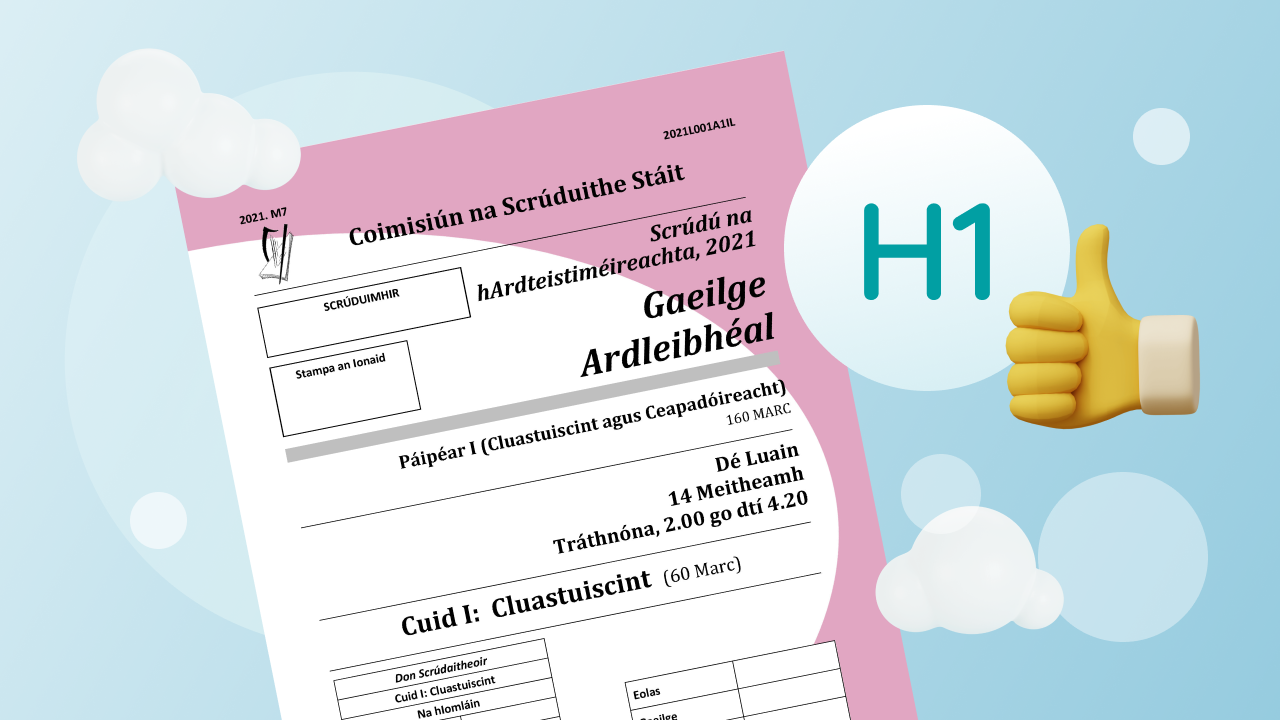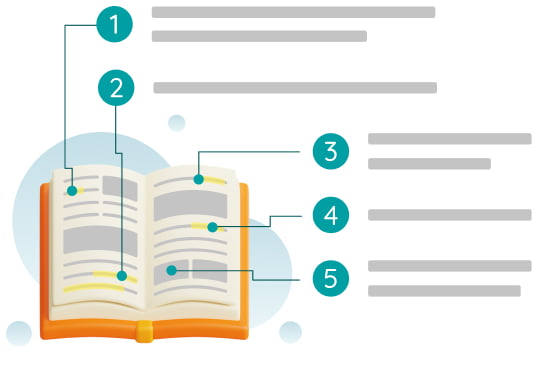Coming from the Gaeltacht, Irish has always been a natural thing for me but I can understand how people can find it difficult (the grammar and the vocabulary especially). Hopefully, this guide will help you approach the Leaving Cert Irish syllabus and exam in the best way possible to ensure you top marks.
How to get a H1 in Leaving Certificate Irish
 By Eimear Dinneen - 14 minute read
By Eimear Dinneen - 14 minute readIn this guide, Eimear gives her advice on how to get a H1 in Leaving Cert Irish.

Jump to:
Introduction

The oral exam
If you’re anything like me, this part of the Leaving Cert will be the scariest. I dreaded both orals (Irish and French) and was unbelievably nervous at the thought of them. However, on the mornings of the exams, I was totally calm and in the end, I found them to be extremely overhyped. The examiners are usually really nice and they’ll help you out whenever they can. If you’ve put in the work and effort (which I’m sure you will have), there’s really no need to be nervous. Take the opportunity to show off how well you can do.
The exam generally only lasts 12-15 minutes and trust me, it flies. It’ll be over in no time. The exam itself is worth 40% of your overall mark and has 4 main parts (marked out of 240). Let's have a closer look at the four main sections of the oral (below).

Beannú (reception)
When the examiner calls you in, remember to make a good impression. Give them a smile and say "Dia dhuit. Conas atá tú?", or if they ask you first, "Dia is Muire dhuit" is the answer. If they have to see 20 plus students each day, it will make their job and day easier and better if you’re friendly and nice. Then, you introduce yourself. Tell the examiner your date of birth, your exam number and where you live. Just learn this off by heart.
Don’t fall into the trap of saying "Is as Baile Átha Cliath mé", when asked "cad as duit?". The correct way is to say, "Is as Baile Átha Cliath dom". This is a common mistake that might lose you easy marks.

Léamh filíochta (poetry reading)
What to expect
This is an easy 35 marks. There’s only a choice of 5 poems which you can be asked (these are also conveniently on your course anyway). When he or she picks out a poem for you, all you must do is read out the title of the poem and the poet, e.g. "Colscaradh, le Pádraig Mac Suibhne". You then proceed to read the poem.
Use phonetics
In the exam (on the sheet with the poems), you are allowed to write in the phonetics for words which you might have difficulty with. For example, for ‘Colscaradh’, the word ‘shantaigh’ was difficult to say by a lot of students in my class so we were able to write ‘how-n-tig’ above it. Apart from that, just practice reciting it over and over until you’re 100% sure you can read it without fault.

Sraithpictiúirí (picture series)
What to expect
There are 20 overall and you will be asked about one of them. The examiner will let you choose one (without you being able to see it) and you will get a few moments to prepare yourself. Then, you must read out the title and proceed to describe each picture.
Be confident in your Irish
Each school has different methods of describing them; some give the characters’ names while others don’t and some do it in the past tense while others do it in the present. To be honest, as long as your Irish is spot on, the way you describe it doesn’t make a huge difference.
Indirect speaking
Be careful with indirect speaking (caint indíreach), e.g. "Deir Síle…". If you say this, it has to be followed with ‘go’ or ‘nách’. If you say "Deir Síle tá…" you’ll get docked marks straight away.
Questions
Once you have the pictures described, the examiner will ask you 3 questions about the pictures. They are generally simple questions such as, "cén t-am é ar an chlog i bpictiúr a 3?". You then ask them 3 questions in return (keep them simple).
When studying for this section, I recommend reciting how you would describe the sraithpictiúirí out loud to yourself or someone else. Ensure you know the vocabulary for certain difficult words or items that may appear in some of the pictures.

Comhrá (conversation)
What to expect
This part of the exam is just a general chat between you and the examiner. They will usually ask you simple questions about you, your family, school, the locality and pastimes you have. Try to have a good bit prepared on each topic so that there won’t be a lull in the conversation. Being able to continue talking earns more marks.
Testing your tenses
Generally, they will try to ask you a question which will make you answer in the past tense, the future tense and the conditional (modh coinníollach). Therefore, make sure you know your tenses well. The examiners tend not to go too obscure and you can often predict the range of questions they will ask. For example, the only few questions they might ask for the future tense would be "Cad iad na pleananna atá agat don bhliain seo chugainn?" or "Cad a dheinfidh tú an deireadh seachtaine seo chugainn?". For the modh coinníollach, they don’t usually stray far from questions like "Cad a dheinfeá dá mbeifeá i do phríomhoide?" or "Cad a dheinfeá dá mbuafá an crannchur náisiúnta". Make sure to have answers prepared for these questions so you can just recite them if asked in the exam.
Practice makes perfect
Unfortunately, speaking Irish seems to have become less popular over the past few years and students don’t want to speak it around school or with their friends. However, if you want to do well in the béaltriail, especially in the comhrá section, you have to be able to speak fluently and seamlessly. The only way to get this effect is to speak in Irish often such as at the lunch table, at home, in class, etc. It’s really brilliant practice.
If the examiner does ask you a slightly difficult and obscure question, it probably means that they have acknowledged that you are good at speaking Irish and want to see if they can challenge you. It’s usually a good sign if you get asked a weird question.

Exam paper breakdown
Paper 1
Paper 1 is made up of the aural exam and the composition.
The aural exam (an chluastuiscint)
This is the first thing you will do in your exam. It’s worth 60 marks and lasts about 20-25 minutes. There are 3 sections:
-
Cuid A (advertisements)
-
Cuid B (conversations)
-
Cuid C (news pieces)
Here are some tips and tricks for this section:
What to expect
You get to hear each section twice; once all the way through and once with breaks. You will get time before each section to read through it. The first thing I would always do upon opening the paper before the CD started was underline the keywords in each question. This way, I knew what words to expect and what to listen out for.
Write down keywords
Sometimes, the speakers can speak quite quickly and you don’t have time to write down all the answers in one go. In this case, you should write keywords in the space provided and when you have time after, write in the full answer.
Different dialects
Different dialects can get tricky. If, like me, you’re from the south of Ireland, the northern accent might throw you off and vice versa. I would advise knowing the traits of each dialect so you can recognise different words. For example, I found the Donegal accent difficult to understand at first but then I learned that ‘cn’ is pronounced as ‘cr’ in that dialect. So, if I heard anything with the phonetic sound of ‘cr’, I knew how to understand it. Another example is the word ‘conas’. This is what people from Munster might say but in Connacht, it’s usually ‘céard’ and in Ulster, it’s ‘caidé'.
Spelling and grammar
Try to make sure your spelling is quite good because if it’s bad they’ll have to dock you some marks at the end for poor spelling (even if your answer is right). The same goes for your grammar.

The composition (ceapadóireacht)
What to expect
This section of the exam is worth 100 marks and you are given almost 2 hours to complete it. This should be more than enough time to write about 4/5 pages but don’t waste your time either. You have 9 options to choose from (5 options are under the heading ‘Aiste nó Alt Nuachtáin/Irise’, 2 are under the heading ‘Scéal’ and 2 are under the heading ‘Díospóireacht/Óráid'). You really get a serious amount of choice here so you shouldn’t have much trouble choosing a title that suits you.
The essay
The essay tends to be the easiest section, especially because you have so many choices and the topics are straightforward. You should have a good introduction, at least 3 paragraphs and a conclusion. Hopefully, you’ll have a good teacher who made you do many essays over the course of 2 years so that you can have lots of topics covered and ensure that you have something prepared for the exam. Otherwise, I recommend writing out essays and getting your teacher to correct them. Also, try to know as much vocabulary as you can for common topics such as alcohol, technology, young people, the education system, etc. as it will show your proficiency in the language. You’ll need to plan out your essay first. This way you can refer back to your plan to see what you can write next.
The scéal
Generally, students avoid the scéal section as it really needs to be excellent. That being said, if you have practiced it and feel it’s the one for you, by all means, go for it.
The díospóireacht/óráid
If you’re going to choose the díospóireacht/óráid, you have to make sure you know the structure of it. The díospóireacht always begins with something like this: “A Chathaoirligh, a mholtóirí, a lucht éisteachta agus lucht an fhréasúra. Is mise _____ agus táim ag caint inniu i bhfábhar/in aghaidh an rún go/nách...”. Also, you’ll need to use phrases and techniques used in debating, such as "ná éist le lucht an fhréasúra nuair a deireann siad…" or "Nách gceapann sibh, a dhaoine uaisle…?" etc. Finally, debating can sometimes be slightly more difficult as you have to stick to one side of the argument, unlike in the essay section.
There are 20 marks for the subject and information (does your essay make sense?) and 80 marks for your standard of Irish/grammar. Therefore, you really must focus on getting this right. I know that it can be really confusing so just try to learn it bit by bit. Maybe concentrate on masculine and feminine nouns first and then try to tackle the tuiseal ginideach, for example.

Paper 2
Paper 2 is made up of the comprehensions, prose, poetry and additional literature.
Léamhthuiscint (the comprehensions)
What to expect
There are two to complete in total. Each consists of an extract/article/report and questions to answer on the piece. I would recommend doing them last because if needs be, you can usually fly through them at the end if you’re short on time as they tend not to be very difficult. Ideally though, you should spend about 35 minutes on each.
Answering the questions
Usually, the answer to a question will just be a sentence from the extract which you can just copy and paste. The question’s answer shouldn’t be hard to find either because you merely have to look for the keywords given in the question and spot it in the paragraph (this pretty much goes for all questions as far as question 6).
Grammar points
In both comprehensions, Q.6 part (a) will ask you to identify a grammar point. For example, you might be asked to identify an example of a feminine word in paragraph 5 or something to that effect. Therefore, you need to know how to identify every aspect of Irish grammar on the Leaving Cert course. If you practice finding these grammar points in different comprehensions, it becomes easier and quicker to identify them. For example, if you’re asked to identify an example of ‘briathar saor san aimsir caite’, after some practice, you’ll know straight away to look for a word ending in ‘aíodh’.
Being asked to comment on the text
In part (b) of question 6, in the first comprehension, you’ll usually be asked to comment on the text in some way, whether it be your opinion on what kind of person Nelson Mandela was, for example, or what the extract told you about a certain era, etc. It needn’t be more than 60 words so just give a short, personal answer on the text and use quotes from the text to back up your answer.
In the second comprehension, part (b) is always stating what kind of literary genre the extract is a part of. There are a few different options:
-
Tuairisc (report)
-
Insint (telling)
-
Plé (discussion)
-
Treoir (guide)
It’s almost always 'tuairisc' or 'insint' so you should be safe enough with knowing both of them. It’s important that you know the difference between them and how to recognise them and their traits as usually, the second part of the question is to identify a trait of that genre that showed you that it is, in fact, that genre. For example, a tuairisc is usually written in the present tense, comes from a news source and is non-personal.

Prós (prose)
What to expect
In this section, you’ll either have studied ‘Prós Ainmnithe’ or ‘Prós Roghnach’. It’s worth 30 marks so you should spend about 25 minutes on it and write about a page and a half (2 if you can). 25 marks go for how well you actually answered the question and how much appropriate information you give and 5 marks go for your Irish ability. So although your standard of Irish/grammar isn’t as central here, it’s still important if you want high marks.
Be prepared
You’ll study 5 texts if you’re doing Prós Ainmnithe. These will change with the syllabus though so don't assume that because one text came up the year before that it won’t come up again for your exam because it has happened in the past. Study all of them well and be prepared to answer a question on any of them. For all texts, you’ll need to know the order of the story, traits of the characters, themes and the plot. These are essential for answering any question so by knowing these, you are ensuring that you can tackle any question.
The film, short story and folklore options
For the film, you’ll need to know film techniques like close-up shots, sound, music, lighting, etc. and the effect they have on the film. For the short stories, you’ll need to know the traits of a short story, e.g. if it has an abrupt ending, if the theme is universal, etc. For the folklore, you’ll need to know traits of folklore such as the use of magic, black and white characters, the inclusion of heroes, etc.
As 25 marks are going for information, you can’t just write out an essay that you have learned off by heart if it doesn’t match the question. You need to understand and answer the question correctly. Repeat the question or the keywords from it a few times in your response to help you keep on track.

Filíocht (poetry)
What to expect
Like in the prose section, you’ll have either studied ‘Filíocht Ainmnithe’ or ‘Filíocht Roghnach’. There are 30 marks going for this section and you study 5 poems.
Important information to know
For every poem, it’s essential you know the theme, the main emotions, the message that is portrayed in the poem, poetic techniques (metaphors, imagery, assonance, repetition, etc.) and finally, the life and work of the poet. You need to know the poet’s name as it will not be given.
Quotes
Unlike in English, the poem is given to you so you needn’t go learning quotes. However, like in English, you still need to quote the poem in your response to back up your answer.

Litríocht bhreise (additional literature)
What to expect
This section is worth 40 marks and there are 6 options to choose from. You can only choose one of these because your school will only have studied one so you must answer whatever question comes up.
Important information to know
The questions are usually either on a character or on a theme/subject matter. It is essential that you know all the main characters’ qualities, the order of the story and its themes.
Your answer
5 marks are going for your Irish and 35 marks are going for information. Your answer has to be full of information from the story (this proves you know what you’re talking about) and it has to answer the question. If it doesn’t, you’ll lose a lot of marks. Your response should be at least 2 pages long (2-3 paragraphs should suffice) and I would spend about 30/35 minutes on this section.

Go n-éirí leat sa scrúdú! You'll be great.

Having spent previous years contributing to content creation, sales and communications, Eimear now manages the customer support and communication teams. Her enthusiasm for culture, travel and languages means she's lived in France, Germany and Scotland to date, and her favourite thing to do is try new food.
